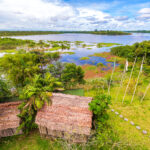
Mining is one of the fastest growing causes of deforestation, with a new report published by the World Resources Institue (WRI) revealing that 1.4 million hectares of forests, an area the size of Montenegro, was lost to the extraction of coal, iron and industrial minerals for the 20 years to 2020.Since the turn of the century, mining has increased by 52%. This includes tropical primary rainforests, some of the world’s most important ecosystems where mining is a growing loss driver, and Indigenous and local community territories, where people depend on forests for their livelihoods.
More than 89% of the loss is concentrated in just 11 countries, including Indonesia, Brazil, Russia, the United States, Canada, Peru, Ghana, Suriname, Myanmar, Australia and Guyana.
A series of recently published data is shining a new light on patterns of deforestation in the Amazon, revealing where crops, cattle ranching and mining are encroaching on the rainforest.
Some of the crops are well-known drivers of deforestation, such as soy, but lesser-discussed crops are also present in the region, such as rice and sorghum.
Following the Programme for the Endorsement of Forest Certification’s (PEFC) recognition of the Guyana National Forest Certification System (GNFCS), the Ministry of Natural Resources is delighted to announce that Guyana’s aspiration to achieve global standards of sustainable forest management has again been recognised internationally. All forest management and chain-of-custody certificates issued by the GNFCS are now considered equal to those from the PEFC International certification system.
Amazon nations have attacked in a joint declaration the “proliferation” of environmental rules in trade, echoing a growing backlash against new EU deforestation requirements.
The final document does not single out the European law specifically, but it condemns “the proliferation of unilateral trade measures based on environmental requirements and norms which constitute trade barriers”.
Mongabay has begun publishing a new edition of the book, “A Perfect Storm in the Amazon,” in short installments and in three languages: Spanish, English and Portuguese.
Chronicling the efforts of nine Amazonian countries to curb deforestation, this edition provides an overview of the topics most relevant to the conservation of the region’s biodiversity, ecosystem services and Indigenous cultures, as well as a description of the conventional and sustainable development models that are vying for space within the regional economy.
The Council has adopted an agreement to improve forest governance and help combat illegal logging in Guyana. The Voluntary Partnership Agreement (VPA), which the EU and Guyana signed in Montreal on 15 December 2022, aims to strengthen law enforcement in the forestry sector and ensure that timber products exported to the EU have been legally produced.
Under the recently signed agreement with Hess Corporation for the selling of the country’s carbon credits, Amerindian communities around Guyana will receive about US$112 million.
The revelation was made by Vice President Dr. Bharrat Jagdeo during the historic signing ceremony on Friday at the Baridi Benab State House.
He said that this is consistent with a pledge that Amerindian communities, both in forested and non-forested areas, will receive 15% of the proceeds from any sale of forest carbon.
According to the VP, Guyana would receive $187 million as compensation for the so-called “legacy era” (2016-2020). According to the agreement, payments of $250 million for the years 2021 to 2025 and $350 million for the years 2025 to 2030 are anticipated.
The distribution and use of these money will be decided by the communities.
Guyana and the European Union on Thursday, agreed on a detailed roadmap for implementing the Guyana-EU Forest Law Enforcement, Governance and Trade (FLEGT) Voluntary Partnership Agreement (VPA) which aims to improve forest governance and verify the trade in legal timber.
The only English-speaking nation in South America has one of the continent’s best track records for Amazon rainforest protection – and an ad hoc patrol group of Indigenous farmers, teachers, and hunters tracking loggers and wildcat miners is part of the reason why.
Click here to access the Global Illegal Logging and Associated Trade (ILAT) Risk assessment tool and to download the Forest Trends User Guide describing the functionality of the ILAT Risk Data Tool.
Click here to access the Cattle Data Tool.









